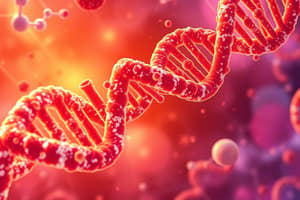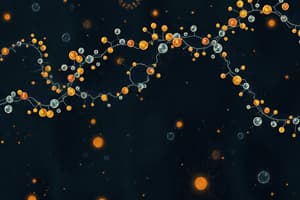Podcast
Questions and Answers
¿Cuál es la función principal de las DNA polimerasas durante la replicación del ADN?
¿Cuál es la función principal de las DNA polimerasas durante la replicación del ADN?
- Cortar el ADN en fragmentos de Okazaki.
- Eliminar nucleótidos incorrectos del ADN en replicación.
- Agregar nucleótidos a las cadenas de ADN en crecimiento. (correct)
- Desenrollar la doble hélice parental.
¿Cuál es la función de la hebra líder (leading strand) durante la replicación del ADN?
¿Cuál es la función de la hebra líder (leading strand) durante la replicación del ADN?
- Detener la replicación del ADN.
- Permitir el crecimiento continuo de una nueva hebra hija. (correct)
- Moverse en dirección opuesta al proceso de síntesis de ADN.
- Sintetizar el ADN con discontinuidades.
¿Cuál es la función principal de los fragmentos de Okazaki en la replicación del ADN?
¿Cuál es la función principal de los fragmentos de Okazaki en la replicación del ADN?
- Sintetizar fragmentos cortos de ADN en la hebra rezagada. (correct)
- Agregar nucleótidos a la cadena de ADN de manera continua.
- Corregir errores durante la replicación del ADN.
- Detener el proceso de replicación.
¿Cuál es el papel principal de la DNA helicasa en la replicación del ADN?
¿Cuál es el papel principal de la DNA helicasa en la replicación del ADN?
¿Qué clase de DNA polimerasa tiene capacidades de corrección (proofreading) para identificar y eliminar errores en la replicación?
¿Qué clase de DNA polimerasa tiene capacidades de corrección (proofreading) para identificar y eliminar errores en la replicación?
¿Qué enzima es responsable de extender el fragmento de Okazaki en la hebra rezagada?
¿Qué enzima es responsable de extender el fragmento de Okazaki en la hebra rezagada?
¿Cuál es la función principal de los fragmentos de Okazaki durante la replicación del ADN?
¿Cuál es la función principal de los fragmentos de Okazaki durante la replicación del ADN?
¿Qué función cumple la DNA helicasa durante la replicación del ADN?
¿Qué función cumple la DNA helicasa durante la replicación del ADN?
¿Cómo se diferencian los fragmentos de Okazaki en E. coli y en mamíferos?
¿Cómo se diferencian los fragmentos de Okazaki en E. coli y en mamíferos?
¿Qué sucede cuando la DNA polimerasa encuentra un fragmento de ARN en la hebra rezagada?
¿Qué sucede cuando la DNA polimerasa encuentra un fragmento de ARN en la hebra rezagada?
Flashcards are hidden until you start studying
Study Notes
DNA Replication Overview
DNA replication is a crucial process that ensures the accurate transmission of genetic information from one generation to another within cells. It involves copying the two strands of the double helix structure of DNA into new complementary strands, effectively creating identical copies. This process occurs during cell division and is essential for maintaining genome stability and preventing mutations.
The key components involved in DNA replication include enzymes such as DNA polymerase and proteins like DNA helicase. These molecules work together to unwind the parental double helix, synthesize the new strands using the original strands as templates, and rewind the newly created double helix back onto itself.
Components of DNA Replication
DNA Polymerase
DNA polymerases are specialized enzymes responsible for adding nucleotides to growing chains of DNA. They have proofreading capabilities, meaning they can identify mistakes made during replication and remove them. There are three classes of DNA polymerases: A-, B-, and X-, with each class having different functions related to DNA repair and replication fidelity.
Leading Strand
The leading strand is the template strand on which the continuous growth of a new daughter strand occurs. Because it moves continuously in the direction of DNA synthesis, it does not require any special structures to accommodate the active synthesis machinery.
Lagging Strand
In contrast to the leading strand, the lagging strand experiences discontinuous growth due to the presence of RNA primers. As the polymerase enzyme encounters these primers, it extends the growing strand by incorporating nucleotides until the next primer is reached. The resulting pieces are called Okazaki fragments.
Okazaki Fragments
Okazaki fragments are short stretches of DNA synthesized by the action of multiple DNA polymerase enzymes moving in opposite directions along the lagging strand template. In Escherichia coli (E. coli), there are typically seven Okazaki fragments per origin of replication, while in mammals, this number ranges between approximately 80–170 per cell cycle.
DNA Helicase
DNA helicase is an enzyme that plays a critical role in separating the two antiparallel strands of the duplex DNA molecule. This separation allows access to the individual strands, enabling their transcription or replication. Helicases are vital for processes such as DNA replication initiation and progression through the fork.
Conclusion
Understanding how DNA replication works helps us appreciate why organisms need to make sure it happens accurately—otherwise, we could end up with all sorts of problems ranging from misshaped body parts and missing limbs to cancerous tumors. By studying the molecular mechanics, as well as the protein complexes involved, scientists are able to develop therapies and treatments for various diseases caused by mutated genes.
Studying That Suits You
Use AI to generate personalized quizzes and flashcards to suit your learning preferences.




